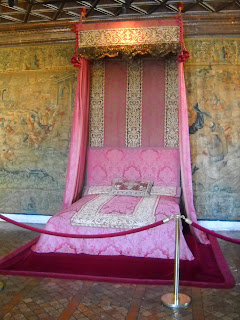 We decided to visit one of the best know castles in the
valley first. The Château de Chenonceau is an
We decided to visit one of the best know castles in the
valley first. The Château de Chenonceau is an architectural mixture of late Gothic and early Renaissance, Château de Chenonceau. It receives around 1,300,000 million visitors a year.
The people who kept the castle safe:
 Katherine Briçonnet
(ca. 1494–1526) was a French noblewoman, who was influential in designing the
Château de Chenonceau between 1513 and 1521, taking important architectural
decisions while her husband was away fighting in the Italian wars.
Katherine Briçonnet
(ca. 1494–1526) was a French noblewoman, who was influential in designing the
Château de Chenonceau between 1513 and 1521, taking important architectural
decisions while her husband was away fighting in the Italian wars.
In 1547, Henry II offered the château as a gift to his
mistress, Diane de Poitiers, who
became fervently attached to the château along the river. In 1555 she
commissioned Philibert de l'Orme to build the arched bridge joining the château
to its opposite bank. Diane then oversaw the planting of extensive flower and
vegetable gardens along with a variety of fruit trees.
 After King Henry II died in 1559, his strong-willed widow
and regent Catherine de' Medici
forced Diane to give up the Château.
Queen Catherine then made Chenonceau her own favorite residence, adding
a new series of gardens. As Regent of France, Catherine would spend a fortune on the
château and on spectacular nighttime parties. The grand gallery, which extended
along the existing bridge to cross the entire river, was dedicated in 1577.
After King Henry II died in 1559, his strong-willed widow
and regent Catherine de' Medici
forced Diane to give up the Château.
Queen Catherine then made Chenonceau her own favorite residence, adding
a new series of gardens. As Regent of France, Catherine would spend a fortune on the
château and on spectacular nighttime parties. The grand gallery, which extended
along the existing bridge to cross the entire river, was dedicated in 1577.
Henri IV obtained Chenonceau for his mistress Gabrielle d'Estrées by paying the debts
of Catherine de' Medici, which had been inherited by Louise and were
threatening to ruin her. In return Louise left the château to her niece
Françoise de Lorraine, at that time six years old and betrothed to the
four-year-old César de Bourbon, duc de Vendôme, the natural son of Gabrielle
d'Estrées and Henri IV. The château belonged to the Duc de Vendôme and his
descendants for more than a hundred years. The Bourbons had little interest in
the château, except for hunting. In 1650, Louis XIV was the last king of the
ancient régime to visit.
 In 1733 the estate was sold for 130,000 livres to a wealthy
squire named Claude Dupin His wife, Louise Dupin. Louise Dupin was "an
intelligent, beautiful, and highly cultivated woman who had the theater in her
blood." Louise Dupin's literary salon at Chenonceau attracted leaders of the Enlightenment. The widowed Louise Dupin saved the château from destruction
during the French Revolution, preserving it from being destroyed by the
Revolutionary Guard because "it was essential to travel and commerce,
being the only bridgeacross the river for many miles."
In 1733 the estate was sold for 130,000 livres to a wealthy
squire named Claude Dupin His wife, Louise Dupin. Louise Dupin was "an
intelligent, beautiful, and highly cultivated woman who had the theater in her
blood." Louise Dupin's literary salon at Chenonceau attracted leaders of the Enlightenment. The widowed Louise Dupin saved the château from destruction
during the French Revolution, preserving it from being destroyed by the
Revolutionary Guard because "it was essential to travel and commerce,
being the only bridgeacross the river for many miles."
In 1864 Marguerite Pelouze , a rich heiress, acquired the
château. Around 1875 she commissioned the architect Félix Roguet to restore it.
He almost completely renewed the interior and removed several of Catherine de'
Medici's additions.
José-Emilio Terry, a Cuban millionaire, acquired Chenonceau
from Madame Pelouze in 1891. Terry sold it in 1896 to a family member,
Francisco Terry. In 1913, the château was acquired by Henri Menier, a member of
the Menier family, famous for their chocolates, who still own it to this day.
After some damage in both world wars, the Menier family
entrusted the château's restoration to Bernard Voisin, who brought the
dilapidated structure and the gardens back to a reflection of its former
glory.











2 comments:
What a wonderful history lesson. I always enjoy learning something new. The castle is breathtaking. Oh, to own something as grand as that!
I am a history buff, and I guess it shows. It's hard to wrap my brain around history that's thousands of years old. When here on the west coast is usually a couple of hundred years.
Post a Comment